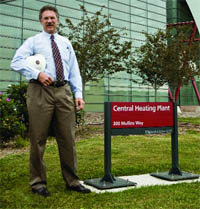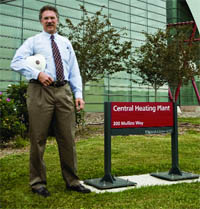
Power House
New Central Heating Plant at UMass Sets the Standard for Energy Efficiency
The new, $133 million central heating plant, or CHP, at UMass Amherst has been drawing plenty of attention and winning its share of accolades from the industry trade publications since opening last year. The reasons are simple: the new standards it is setting for efficiency and low emission levels, and the manner in which it builds a bridge of sorts between older technologies and the future of renewable energy.
John Mathews nearly wore out the phrase state of the art as he talked about the new central heating plant (CHP) at UMass Amherst.
He used it to describe nearly every facet of the gleaming, $133 million facility, the building of which has been Mathews primary focus for more than a decade now.
Indeed, while standing on the roof of the glass and steel structure, Mathews pointed out the aesthetic refinements of the building, from smokestacks sheathed with a metal mesh scrim to south-facing high-tech windows, to that soaring roofline echoing the neighboring Mullins Center.
Mathews, assistant director of the Facilities Planning Division at UMass Amherst, has been the project manager for the $133 million CHP, and after 12 years, hes happy not only to see the project finally finished, but to have it recognized as a standard-bearing example of the future for district energy facilities.
Dedicated this past April, the CHP is the latest example of UMass leading the way in providing responsible answers to the energy needs of the 21st century. The technology utilized throughout the facility, from mechanical to architectural, has helped contribute to a 30% reduction of the schools carbon footprint. Overall, the CHP has reduced the greenhouse gas emissions at UMass by approximately 75%.
Mathews gave BusinessWest a tour of the facility recently, and described the innovations that have made this power house the latest word in efficient energy production.
Steam of Consciousness
The CHP replaces a power plant that was completed in 1910. Mathews joked that the campus technology had been a contemporary of Teddy Roosevelt as he stormed Cuba during the Spanish American War. The university was then in its heyday as an agricultural college.
That technology had been added onto in the 40s, 50s, and 60s, he continued, but you need the reliable and quality power today to function as a modern research facility, which in so many ways UMass has become.
Financed by the UMass Building Authority (UMBA), a separate state agency from the university, the facility was first blueprinted in the 1990s, when the school decided that the time had come to finally replace the old coal-fired power plant, which over time became close to the hub of the growing campus.
The UMBA is responsible for all facets of university capital construction, from financing to design and construction. Upon completion, the buildings are then turned over to the campus physical plant operations. In the case of the CHP, the decision was made to use the same architectural firm, Cambridge Seven, that designed the Mullins Center.
The 1,400-acre Amherst campus has more than 10 million square feet of space in more than 200 buildings. More than 25 miles of steam lines bring power to these buildings, and the CHP is at the core of it all.
The primary energy needs for the university are steam and electricity. Steam is used throughout the year, for hot water, heating in the winter, but also used to run absorption chillers in warmer months. As steam cools, it contracts by 1,000%, Mathews explained. That vacuum allows us to generate cold water that is then put into air conditioners.
The heart of the CHP is a 10 megawatt gas turbine powered by a jet engine. The process is called combined-cycle technology, and while the machinery looks high-tech, Mathews description makes it seem pretty simple.
We fire natural gas or oil into the jet engine, and that spins an electric turbine generator which makes electricity, he said. It has an air compressor, with rows of fan blades that compress the air to 450 pounds per square inch, where we inject gas into a combustion chamber. Gas expands as it combusts, and it spins the fan blades, spins the rotor, and makes electricity.
The heat from that process exhausts at 900 degrees Fahrenheit, he continued, and that exhausts into a heat recovery boiler. Theres an additional duct firing natural-gas burners like a backyard barbecue, but in an industrial size, 72 burners, and that fires the temperature in the boiler up to about 1,500 degrees Fahrenheit.
Thus, the two demands for the campus, electricity and steam, are met. According to the CHPs specs, the gas turbine produces 10 million watts of electricity at 13.8 kilovolts. An additional 4.5-megawatt steam turbine generator adds to the electrical output.
While most people would think that a state-of-the-art and efficient district energy facility would incorporate some form of renewable fuel source such as solar, geothermal, or wind, Mathews explained that for the requirements of this power plant, fossil-fuel consumption is still the best possible way to meet the energy needs of the university community.
The CHP is an important bridge between the older technologies and the future of renewable energy technologies, he said. Solar is still very expensive per kilowatt hour, and so are fuel cells, which are 10 times the cost of energy from fossil fuels. Nuclear power is hard to site. Renewable energies just need more time to develop. In the meantime, we have these technologies available to us that will have a significant contribution in reducing greenhouse gas emissions.
So what the CHP does do incredibly well is use existing methods of fuel consumption and make them more efficient than ever before. Traditionally, a power plant utilizing steam turbines for the production of electricity captured about 35% of the available energy in their fuel, wasting the other 65% into the atmosphere and the environment as ash. The CHP uses over 80% of the available energy in the fuel.
Almost close to optimum use per pound of fuel is captured here, Mathews continued. Per pound of fuel, we are generating twice as much electricity as a traditional power plant, plus half the greenhouse gas emissions of a power plant. This facility was responsible for significant reductions of greenhouse gas emissions for all state-owned facilities in the Commonwealth. This one facility. And theres not a solar cell in the place.
He said that state agencies have wanted a power plant of this sort to be built for a long time. The Massachusetts DEPA, along with those of California and New York, has been pushing the industry to do better and be more efficient.
The permits they issued for this facility were stricter than those for the facility they did before ours, Mathews said, and the permits after this will be even stricter. Theyre pushing the vendors to further develop their technology, to lower total emissions.
We are meeting the most stringent air-pollution-control standards in the country, he continued. There is no other facility of this kind, of this size, in the country that has such low emission limits as we have. So it has really challenged the manufacturers to meet those low limits. They are trying to use these technologies to make the higher limits around the country meet these limits.
But the emissions arent the only aspect of the CHP that make it a model for efficiency.
Waste Not, Want Not
In the past, steam traveling from the power plant to the campus was lost in the process, and not successfully recirculated back to the source. Mathews estimated that the older facility would get on average of 80% to 90% of the steam returned.
To make up for that loss, additional water was pumped in from the Amherst town water supply. We were using about 150,000 to 250,000 gallons per day of make-up water for steam, he said.
But in true fashion for a model of efficiency, the CHP uses so-called gray water, non-industrial wastewater, from the nearby Amherst town wastewater treatment plant. We treat it through two different treatment processes, sterilizing it and also reducing the suspended materials and minerals, he explained. By doing so, we are diverting about 11% of its flow to the Connecticut River.
Recycling the water saves something in the neighborhood of 65 million gallons per year taken from the drinking water supply, he continued.
But its not just the state agencies that have recognized the CHP as a standard bearer for regional energy facilities.
Combined Cycle Journal, the industrys leading trade publication, gave the UMass facility one of its highest recognitions for 2008, the Pacesetter Plant Award. The International District Energy Assoc., a non-profit with goals of energy efficiency and environmental quality, gave UMass Amherst an award at the CHPs opening for leading sustainable campus in America. Mathews said that he is currently seeking federal recognition, with an award from the U.S. Department of Environmental Protection for Combined Cycle Technology.
But the CHP is just one example of the school taking the lead with regard to its own environmental impact.
As a campus, environmentally, we have just instituted about 40 energy-conservation measures, said Mathews. We replaced 12,000 light fixtures on campus, about 5,000 plumbing fixtures, modernized our chillers and air-conditioning equipment. We have effectively reduced our steam and electrical demand by over 20% during the design of this project such a reduction in demand, in fact, that the CHP was able to eliminate one of the large boilers from the facilitys array.
The CHP may be the tip of the spear for central power plants, but for the school also. UMass will further its green commitment with two new buildings in the pipeline. As Mathews puts the finishing touches on this building, he mentioned a new police station just out to bid now which is designed to be a LEED gold structure, and a $144 million science building, with a LEED level to be determined.
With the power plant designed to meet the schools energy demands for the coming decades, Chancellor Robert Holub said, this first-rate building advances UMass Amhersts leadership in higher education with development of one of the nations most efficient and environmentally friendly energy facilities. It also will contribute significantly to meeting the governors goals for reducing the carbon footprint of state facilities.
Mathews said that hes given tours of the CHP to organizations facing similar projects, and hes happy to use the plant as a model of what could be. This is a public facility, so were not here to make a profit, he said. But there are private-sector developers for district power plants throughout the world who are struggling to make this viable for them. Cities and towns and state agencies need to provide more incentive for the construction of these kinds of facilities.
While the university continues to be on the front line for alternative energy sources, its own needs are met for the coming decades by this example of efficient operation. UMass, in more ways than one, is proving again to be a powerhouse in efficient energy answers.





